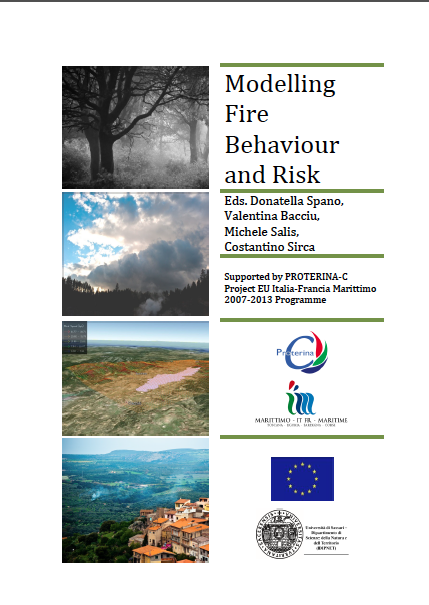Edited by Donatella Spano, Valentina Bacciu, Michele Salis, Costantino Sirca (Department of Science for Nature and Environmental Resources – DipNeT, University of Sassari, Italy; Euro-Mediterranean Center on Climate Change (CMCC), IAFENT Division, Sassari, Italy).
Supported by PROTERINA-C Project: A forecast and prevention system for climate change impacts on risk variability for wildlands and urban areas (EU Italia-Francia Marittimo 2007-2013 Programme).
 Fire is a good servant, but a bad master. It has to be kept under control. Once it is out of control, it has the ability to take away lives and destroy property.
Fire is a good servant, but a bad master. It has to be kept under control. Once it is out of control, it has the ability to take away lives and destroy property.
It is, therefore, critical that the continuous progress in knowledge on fire drivers and causes, together with the advancements in technologies and modeling approaches and the awareness of population and politicians about the risk associated, are the keystones and the scientific bases for the prevention and management activities in order to reduce the risk associated with fires.
The current volume collects most of the papers delivered at the International Conference on Fire Behaviour and Risk, which held in Alghero (Sardinia, Italy) in October 2011 and represents a step forward in the dissemination of relevant scientific results and advances in forest fire research.
The Conference was organized in the framework of the European Project Proterina-C, Italia-Francia Marittimo Programme, co-sponsored by the Global Fire Monitoring Center (GFMC), an action of the UN International Strategy for Disaster Reduction (UN-ISDR), under the patronage of University of Sassari, the Euro-Mediterranean Center on Climate Change (CMCC), the Regional Administration of Sardinia, and the Province Administration of Sassari. The Project involved three cross-border regions (Sardinia, Corsica, Liguria), which face similar several environmental issues, among which fire is one of the main concerns, especially in the Mediterranean Basin.
The volume illustrates the contribution of researchers to scientific and operational knowledge of wildland fire, with particular attention paid to fire behaviour and risk modelling, relationships between climate change and fires, and fire risk impacts at wildland-urban interface.
The report is organized in four sections, reflecting the main theme related to a better understanding of fire behaviour and risk modelling.
The first section is focused on the theme of the relationship between Vegetation and Fire, emphasizing that an accurate knowledge and comprehensive description of fuel characteristics and conditions are critical matters in fire prevention, fire danger, and fire behaviour understanding. The second section, “Climate and Fire”, presents an investigation and analysis of weather and climate conditions that influence forest fires and directly affect fire ignition, spread, and severity. Finally, the last two sections deal with the modelling of fire behaviour, risks, and impacts on the wildland-urban interface.
Several papers presenting the most recent advances in modelling techniques and fire danger forecast attest the high specialization achieved by the scientific community. In addition, the wildland-urban interface (WUI) becomes a global issue, in particular in areas where fires coexist with human presence in dwellings and settlements.
Researches attempted to close the gaps in the research and understanding of the WUI challenges, its characterization, and extent.
Download the book “Modelling Fire Behaviour and Risk”.
CMCC InstitutesCMCC Divisions


